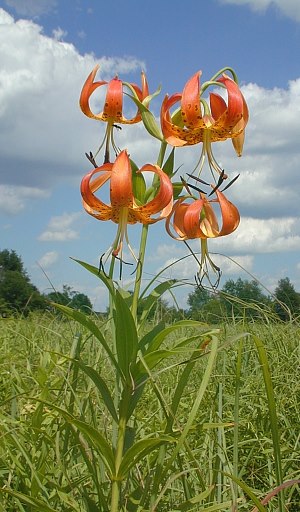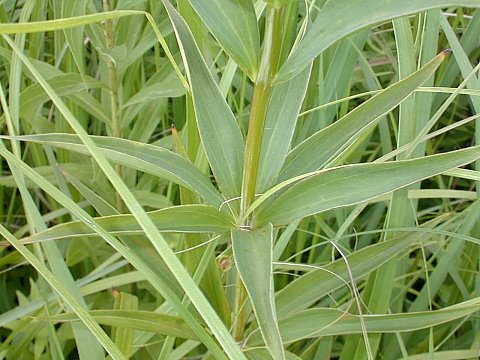Description: This perennial plant is up to 6' tall and unbranched, except at the inflorescence. The central stem is stout and smooth. The leaves usually occur in whorls of 3-9 along the stem, although some of the upper leaves may occur along the stem in pairs or alternate individually. The leaves are individually up to 7" long and 1" across, rather stiff in texture, and sometimes curve upward along their margins. They are lanceolate or narrowly ovate, with smooth margins and parallel venation. Above the terminal leaves of the central stem, 1-12 flowers hang downward from stalks about 4-8" long that spread upward and outward. Some flowering stalks may also appear from the axils of the upper leaves. Each showy flower is about 3-4" across, with 6 tepals that flare outward and then curve strongly backward beyond the base of the flower. These tepals are yellowish orange or green near the base of the flower, and become orange to dark orange towards their tips. They have numerous brownish purple dots toward the throat of the flower. The stamens are quite conspicuous and strongly exerted from the base of the flower, with reddish brown to black anthers that are ½" long or longer in length. They surround a long whitish orange stigma that curls slightly upward and is orange or brown toward its tip. The blooming period occurs from early to mid-summer, and lasts about a month. There is no noticeable floral scent. The oblong 3-lobed seedpods contain closely stacked, flat seeds with thin papery wings – this enables them to be carried some distance by gusts of wind. The root system consists of a white bulb, from which new offsets may form.

Cultivation:
The preference is full or partial sun, rich loamy soil, and moist
conditions. An established plant, however, can withstand some drought.
Growing this plant from seeds is slow and difficult, but relatively
easy from bulbs or transplants. There is some tendency to flop over if
there is inadequate support from neighboring plants.
Range & Habitat:
The native Turk's Cap Lily occurs primarily in a few counties in
southern Illinois (see Distribution
Map). This is a rare plant in the wild in Illinois, although
it is occasionally cultivated in gardens because of the showy flowers.
Habitats include moist meadows in woodland areas, open woodlands and
young flatwoods, thickets, and areas along lakes. This plant is
occasionally introduced into natural areas outside of its original
range.

Faunal
Associations:
Cross-pollination is required for fertile seeds. The large showy
flowers appear to be designed to attract hummingbirds and larger
day-flying insects, such as Sphinx moths, Hummingbird moths,
long-tongued bees, and the larger butterflies. Charles Robertson in Flowers
and Insects (1929) observed
the Greater Fritillary, Monarch, and Spicebush Swallowtail butterflies
as occasional visitors to Lilium superbum, which
was probably Lilium michiganense, as the former
species doesn't occur near Carlinville, Illinois. Larger herbivores,
such as deer and livestock, will consume mature plants, while immature
plants are vulnerable to small herbivores. Small rodents may eat the
bulbs.
Photographic Location:
The photographs were taken at Meadowbrook Park in Urbana, Illinois,
where this species was introduced.

Comments: This is a very beautiful plant. The Turk's Cap Lily can be distinguished from the more common Lilium michiganense (Michigan Lily) as follows: 1) the former species is restricted to southern Illinois, although it may be introduced elsewhere; 2) some of the anthers of the former are greater than ½" long, while the anthers of the latter species are always less than ½" long; 3) the former has white bulbs, while the latter has yellow bulbs, and 4) the former species may have a conspicuous 6-pointed green star at the base of the flower, although this feature isn't always present in some local ecotypes. The stamens of Turk's Cap Lily are even more strongly exerted from the throat of the flower than is the case for the Michigan Lily, and it tends to be a taller, more robust plant.